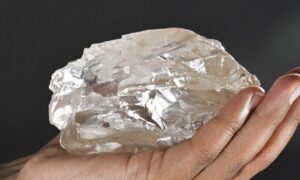For centuries, the Sui people of China’s Guizhou province have gone to Mount Gandeng to collect rocks for good luck. What makes these rocks special? Every 30 years, the mountainside lays dozens of smooth and almost perfectly spherical rock “eggs.”
Guizhou province is a plateau of largely limestone and basalt that has undergone unusual erosion. One such feature is particularly odd.

Rock eggs of different sizes. Photo: VCG
As you venture onto Mount Gandeng, you come across a multi-colored cliff. Its layers of orange, brown, grey, and black rock are heavily eroded and scarred. The cliff face is also pockmarked from top to bottom with large protruding rocks, usually varying in size from 20cm to 40cm. However, some rocks can weigh over 570kg. Usually, the rocks are dark blue or grey.
Good luck stones
Eventually, these extruded rocks pop off the cliff face and fall to the valley floor. The Sui people from the nearby village of Gulu collect and store them in their homes. According to tradition, these special rocks, which look like eggs, give a household prosperity and peace for many years. Each home in Gulu has more than one, and most have collected 70 or more. They refer to the egg-laying cliff as Chan Dan Ya, which means “reef that produces eggs.”
Needless to say, these rocks aren’t eggs but a product of natural processes like weathering and erosion. The cliff face, composed of much softer rock, erodes more quickly than the rock eggs. Every few decades, the cliff’s face erodes enough for the rocks to loosen and fall from their little nooks.
Over 550 million years ago, during the Cambrian period, tectonic movements formed, folded, and faulted the mountain, which was once underwater. It’s believed that underwater rocks became embedded in the mountain. As the mountain erodes, these ancient rocks, smoothed and rounded by water, emerge.
The 20m by 6m cliff is composed mainly of mudstone and other soft calcareous rocks that are easy to break down.

Rock eggs overhang the cliffside. Photo: VCG
How they formed is still a mystery
The rock eggs are concretions — large accumulations of particles that usually take on a spherical shape.
Professor Xu Ronghua suggests that Cambrian rock in Guizhou province has high concentrations of silicon dioxide. “It would take the least effort for the molecules to form a sphere than other shapes,” he says.
However, this is currently a conjecture with no official studies to back it up.
This obscure location deep in the Guizhou province is not the only place on Earth to feature such a curiosity. New Zealand’s Moeraki Boulders and a forest in Arkansas showcase similar rock eggs.






